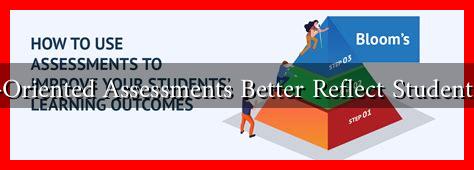-
Table of Contents
Can Goal-Oriented Assessments Better Reflect Student Learning?
In the evolving landscape of education, the methods used to assess student learning are under constant scrutiny. Traditional assessments, often based on standardized testing, have been criticized for their inability to capture the full spectrum of a student’s abilities and understanding. In contrast, goal-oriented assessments are gaining traction as a more effective means of evaluating student learning. This article explores the potential of goal-oriented assessments to provide a more accurate reflection of student learning outcomes.
Understanding Goal-Oriented Assessments
Goal-oriented assessments are designed to align closely with specific learning objectives and outcomes. Unlike traditional assessments that may focus on rote memorization, these assessments emphasize the application of knowledge and skills in real-world contexts. They can take various forms, including:
- Project-based assessments
- Portfolios showcasing student work
- Performance tasks that require critical thinking
- Self-assessments and peer assessments
By centering on clear learning goals, these assessments aim to provide a more holistic view of a student’s capabilities and progress.
The Benefits of Goal-Oriented Assessments
There are several compelling reasons to consider goal-oriented assessments as a more effective means of evaluating student learning:
- Alignment with Learning Objectives: Goal-oriented assessments are directly tied to the curriculum, ensuring that what is assessed is relevant to what students are expected to learn.
- Encouragement of Critical Thinking: These assessments often require students to apply their knowledge in practical situations, fostering deeper understanding and critical thinking skills.
- Personalized Learning: Goal-oriented assessments can be tailored to individual student needs, allowing for differentiation and personalized feedback.
- Increased Engagement: Students are often more motivated to engage with assessments that are relevant to their interests and future goals.
Case Studies and Real-World Examples
Several educational institutions have successfully implemented goal-oriented assessments, yielding positive results. For instance, the Buck Institute for Education has championed project-based learning as a means to enhance student engagement and learning outcomes. Schools that have adopted this approach report:
- Higher student motivation and engagement
- Improved collaboration and communication skills among students
- Better retention of knowledge and skills
Another example can be found in the Pearson Educator Network, which emphasizes the use of formative assessments that align with learning goals. Their research indicates that students who participate in goal-oriented assessments demonstrate greater academic achievement compared to those who rely solely on traditional testing methods.
Challenges and Considerations
While goal-oriented assessments offer numerous advantages, they are not without challenges. Some of the key considerations include:
- Resource Intensive: Developing and implementing goal-oriented assessments can require significant time and resources from educators.
- Training Needs: Teachers may need professional development to effectively design and assess goal-oriented tasks.
- Standardization Issues: There may be difficulties in ensuring consistency and fairness across different assessments.
Conclusion
In conclusion, goal-oriented assessments present a promising alternative to traditional testing methods, offering a more nuanced and comprehensive view of student learning. By aligning assessments with specific learning objectives, fostering critical thinking, and promoting personalized learning experiences, educators can better reflect the true capabilities of their students. While challenges exist, the potential benefits of adopting goal-oriented assessments are significant, making them a valuable consideration for educators seeking to enhance student learning outcomes. As education continues to evolve, embracing innovative assessment methods will be crucial in preparing students for success in an increasingly complex world.

